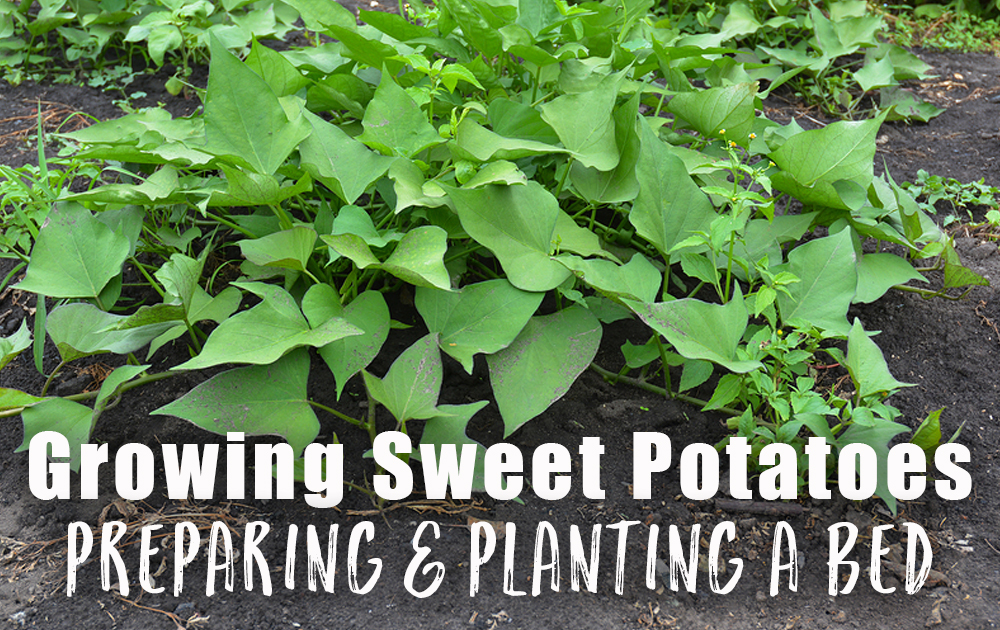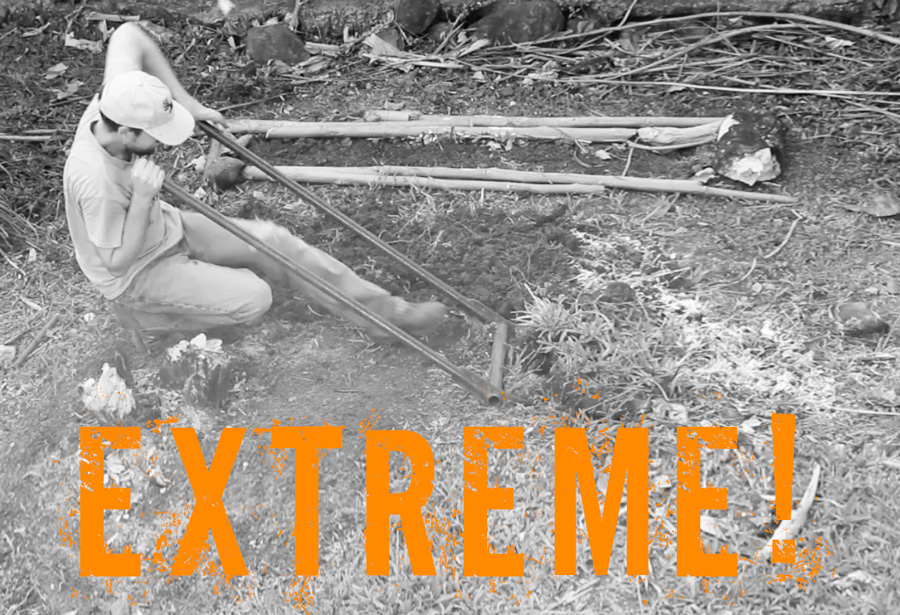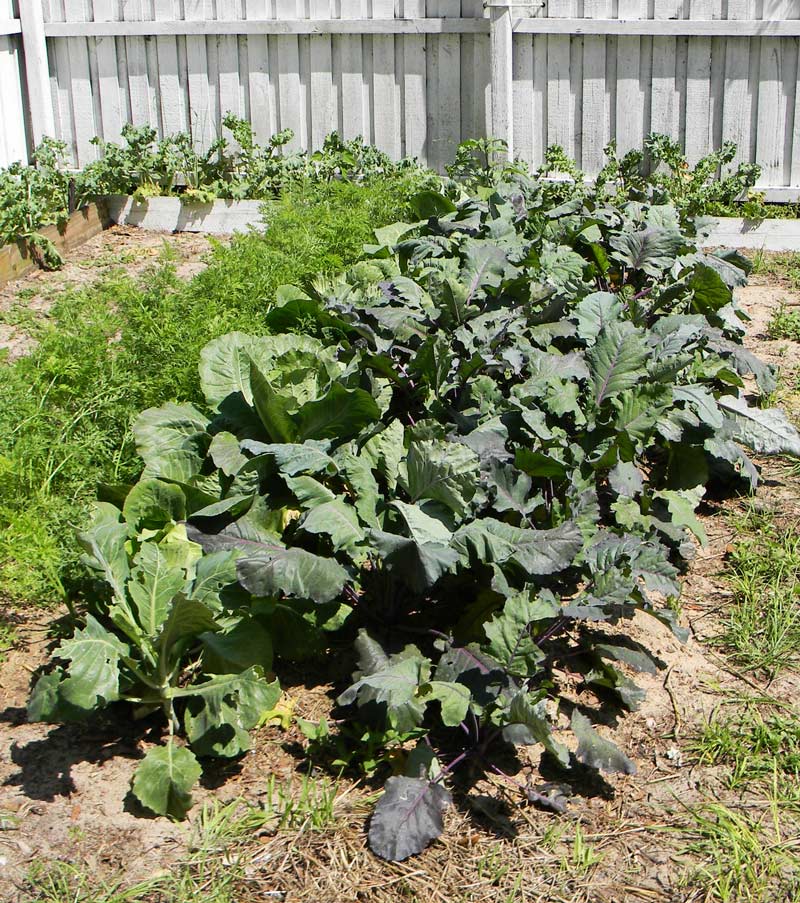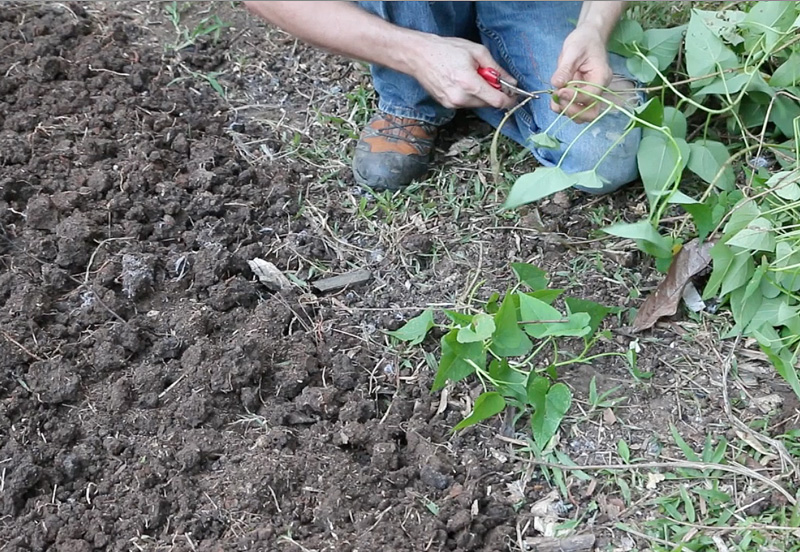Growing sweet potatoes successfully starts with preparing and planting the bed. Do that right, and you’ll reap an abundant harvest!
Growing Sweet Potatoes: Preparing and Planting a Bed
Growing sweet potatoes is easy.
Preparing a bed for sweet potatoes is a little more difficult. It takes some digging and loosening of the soil.
You May Also Enjoy:
“Garden Hand Tools: The Only 5 You Need”
Fortunately, my trusty Meadow Creature Broadfork is always up to the task of growing sweet potatoes.
(Length: 5:17 minutes)
Digging in sandy soil with a broadfork is easy. In rocky clay, it’s not nearly as easy to prepare a bed for growing sweet potatoes. Basically, in clay, it’s an extreme sport.
It’s not impossible, though. That bed took me perhaps 45 minutes to prepare. Mostly, it takes more stomping on the broadfork than I’m used to, plus I had to bust up the big clods.
Sure, it’s work—but it’s work that needs to be done, especially for root crops.
Why Dig a Garden Bed?
The major reason: loose soil. If the soil structure is open and crumbly, plant roots do a lot better. They can dig deep and get the minerals and water they need without having to force their way through hard earth. You’re doing the hard work first to make their lives easier.
Digging garden beds even works well in sand, as I discovered back in Florida.
When your plants have easier lives, they’ll spend more time making delicious things for you to eat.
Growing Sweet Potatoes: The Initial Feeding
When I prepare a garden bed, I rake in compost right at the beginning. In the past, I’ve also used amendments such as lime, blood meal, bone meal, cottonseed meal, and kelp meal—all of which are excellent additions to the soil.
You May Also Enjoy:
“How to Make Fish Emulsion Fertilizer”
“Aerobic Compost Tea, Worm Tea, and Leachate—A Clarification”
Here in the middle of nowhere, I can’t get most of those things, so I stick to compost, biochar, and sometimes seaweed.
You can see a recent bit of bed prep in this video: (Length: 8:47 minutes)
You don’t need a ton of organic matter in the soil. A few percent is fine. Before I plant, I sprinkle about a half-inch cover of compost on a newly dug garden bed and rake or turn it in. The plants really appreciate compost, and it lasts longer and releases its nutrition over time, unlike chemical fertilizer.
You May Also Enjoy:
“5 Free, DIY Compost Activators”
When preparing this garden bed, I used my Back to Eden chicken run compost, which is probably hotter than compost from a typical backyard pile. The plants don’t seem to mind, though.
Here’s how I made that compost: (Length: 8:05 minutes)
Simple. Right?
Planting a Bed of Sweet Potatoes
This is easy as shoo-fly pie.
Just cut some vines and stick them in.
If you don’t have any vines currently growing on your homestead, start your own sweet potato slips with store-bought sweet potatoes.
Use the “toothpicks-and-a-jar” method—or even easier—start potatoes growing by burying them shallowly in a pot of soil. Then cut the vines off of those to plant.
I use a stick to dig holes. Then plant the sweet potato cuttings a few inches deep into the holes.
You May Also Enjoy:
“Growing Arugula: The Rocket in Your Salad Bowl and Garden (With Recipe)”
“Chard en Garde Manger: The Delicious 3-Season Green for Food Security”
They’ll look like they’re going to die for a few days. Don’t worry! They’ll recover as the vines take root. Sweet potatoes are really hardy and tough.
You’ll be amazed by how good these little pieces of vine look after a week or two.
Planting a bed of sweet potatoes takes some prep work. If you do that preparation well, you’ll be rewarded with an abundant harvest.
What Do You Think?
What’s your favorite way to prepare your beds for growing sweet potatoes? Share your insights in the comments below!
_______________
This is an updated version of an article that was originally published on July 22, 2017. The author may not currently be available to respond to comments, however we encourage our Community members to chime in to share their experiences and answer questions!
The Grow Network is a participant in the Amazon Services LLC Associates Program, an affiliate program designed to provide a means for our team to earn fees for recommending our favorite products! We may earn a small commission, at no additional cost to you, should you purchase an item after clicking one of our links. Thanks for supporting TGN!
David The Good is a Grow Network Change Maker, a gardening expert, and the author of five books you can find on Amazon: Compost Everything: The Good Guide to Extreme Composting, Grow or Die: The Good Guide to Survival Gardening, Totally Crazy Easy Florida Gardening, Create Your Own Florida Food Forest, and Push the Zone: The Good Guide to Growing Tropical Plants Beyond the Tropics. Find fresh gardening inspiration at his website TheSurvivalGardener.com and be sure to follow his popular YouTube channel.












COMMENTS(7)
I have only a 8×8 little space it has some fill but I don’t what it is just moved here super hot in summer want to plant late summer do you think the hard crops would be the best like beets onions sweet pot or yams carrots etc how deep must the soul be
Kathleen,
Just a few thoughts….. Find out what gardening zone you are in. (do an online check.. just type in your zip code)
See what can grow there.
Get a general idea of what your “soil PH” is… acid or alkaline.
Better still, go to “Dave’s Garden” online . There’s a treasure trove of free info there… much more than I can help you with.
Start out slowly, and don’t let information overwhelm you.
Best of luck!
Yeah, my neighbor gave me some cuttings from his vine and said just stick them in the ground. I watered 2x per day, but still only one out of five survived. So I tried again, putting them in a jar of water till roots developed. That worked much better. I’m in Houston, TX where it’s beastly hot so that could be a factor.
Neat site
Will this same method work for yams as well?
It’s a pity you don’t have a donate button! I’d most certainly
donate to this outstanding blog! I suppose for now i’ll
settle for book-marking and adding your RSS feed to my Google
account. I look forward to brand new updates and will talk about this blog with my Facebook group.
Talk soon!
David did u build ur broadfork or buy it??? Were can I get one???